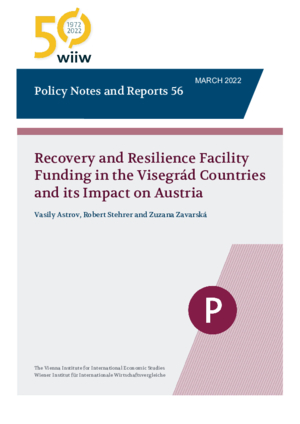Recovery and Resilience Facility Funding in the Visegrád Countries and its Impact on Austria
Vasily Astrov, Robert Stehrer and Zuzana Zavarská
wiiw Policy Note/Policy Report No. 56, March 2022
19 pages including 5 Figures
To benefit from the newly established EU Recovery and Resilience Facility (RRF), the Visegrád countries – Czechia, Slovakia, Hungary, and Poland – have submitted their national recovery plans. All plans mostly rely on EU grants, with only Poland requesting a small amount of EU loans. Although all plans meet the requirements of at least 37% to be spent on green transition and at least 20% on the digital economy, individual spending priorities vary by country. Czechia and Poland, which are strongly dependent on coal power generation, put a great emphasis on renewables and clean technologies, Hungary on health care and green transportation, and Slovakia on digital skills and health care. The annual growth effect of total EU RRF spending is estimated to range, on average, between 0.6 pp in Czechia and 1.4 pp in Slovakia over the next five years. For Austria, the effect will be less pronounced: only 0.3 pp. However, the Austrian economy will benefit from the positive demand spill-overs of RRF in the Visegrád countries due to its extensive production and trade links with the region. The policy implications for Austria include the encouragement of cross-border cooperation on projects (especially in the areas of green transition and health care), an active role in regional stakeholder engagement, and reinforcement of alignment with core EU goals and values.
Reference to wiiw databases: wiiw Annual Database, wiiw FDI Database
Keywords: Recovery and Resilience Facility, Visegrád countries, fiscal multiplier, input-output tables
JEL classification: F0, H30, H50, H77
Countries covered: Austria, Visegrad countries
Research Areas: Macroeconomic Analysis and Policy, Sectoral studies
